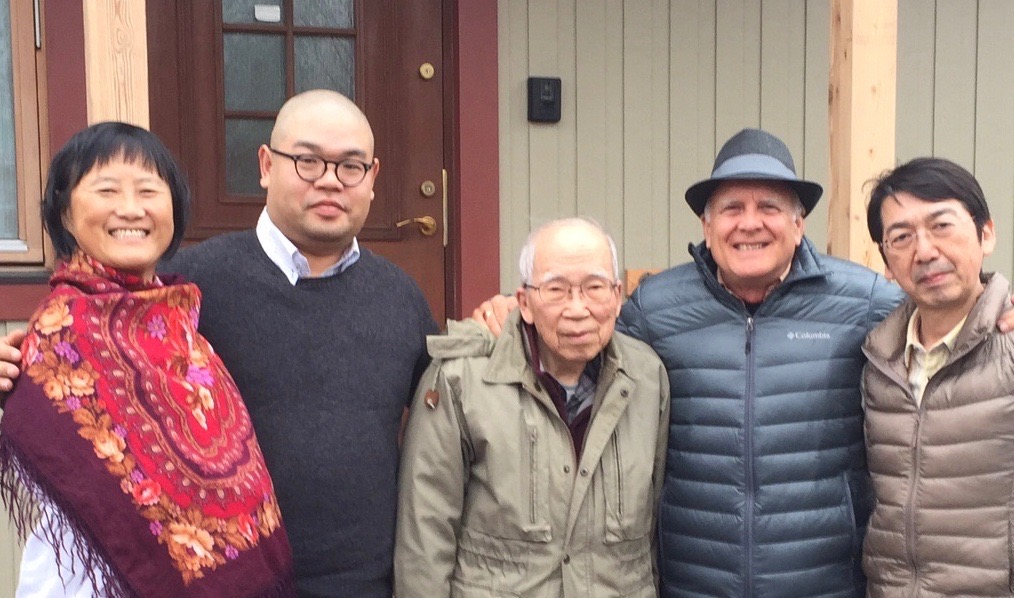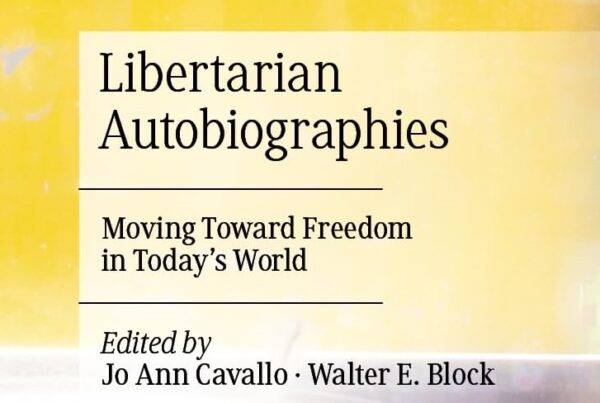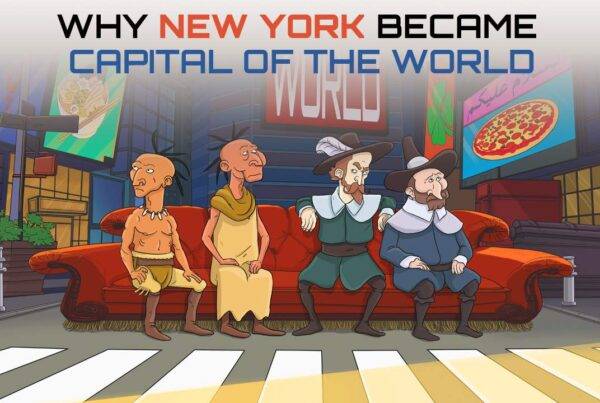
The following is a republished work written by Ken Schoolland, President of Liberty International.
Pictured: Ken Schoolland & Professor Toshio Murata
In the summer of 1984 I overheard two friends discussing the prospects for a libertarian movement in Japan. One of them stated quite bluntly that, despite a free market orientation, the Japanese were too group-oriented to become libertarians. He felt that people had to be firm individualists to be serious advocates of freedom.
The other disputant contended that libertarianism is based on the principle of non-aggression, not strictly individualism. While a libertarian world may be conducive to greater individualism, he argued that it is reasonable to assume that there would be increased incentives for group cooperation. Presumably, voluntary associations would replace the non-invasive institutions that we associate with government today.
As the debate progressed, it became clear that neither person knew very much about the philosophical underpinnings of contemporary Japan. It is often assumed that Japan thrives as some sort of carbon copy of the American economic model, with eastern modifications for close government, business, and employee cooperation. Fortunately, there is a fascinating libertarian heritage in Japan that has provided the foundation for an evolving free society.
Toshio Murata, Professor of Economics at Yokohama College of Commerce, has explained that Japanese history is rife with examples of libertarian thought. Japanese advocates of freedom have exhibited revolutionary zeal, great personal courage, and original theoretical ideas. Enclaves of enthusiastic libertarian influence persist today, amidst an ocean of socialist and interventionist dogma.
LIBERTARIAN ROOTS
Americans might think of Boston or Philadelphia when contemplating the roots of liberty in America. For Prof. Murata these roots are found in Tosa (the old name for Kochi Prefecture), on Shinkoku Island. It was to Tosa that fisherman John Manjiro returned in 1852 after having been shipwrecked, rescued by a whaler, and taken to America for ten years of eye-opening discovery.
During his stay in America, Manjiro studied English and learned about a modern world that had been ignored by Japan during centuries of seclusion.
Back in Tosa, he told stories that inspired many young samurai to seek more knowledge about foreign civilizations. Shortly thereafter, in 1854, the Japanese accepted the opening of ports to American ships and to a flood of new ideas.
Tosa was the fertile ground for many of the rebellious new leaders who brought down the age-old Tokugawa shogunate and struggled for democratic reforms: Taisuke ltagaki, Shojiro Goto, Ryoma Sakomoto, and Kotei Fukuoka. In 1881, Itagaki and Goto founded the Jiyuto (Liberal Party). “The purpose of our party,” proclaimed Itagaki, “is to enjoy nature-given happiness, by propagating the truth of liberty, cultivating popular power, and limiting artificial power.” Later he declared, after an assassination attempt in 1882, “Itagaki should ever die, liberty never die.” This is reminiscent of America’s own Patrick Henry.
One of the outstanding advocates of individualism and of western ideas was Yukichi Fukuzawa, a prolific writer. Lecturing on the need for reform, Fukuzawa wrote that once freedom is acquired, “there is nothing that can withstand man’s courage and intellect.”
Before the rise of militarism in the 1930’s, John Stuart Mill’s On Liberty was popularly used as a philosophy and political science text in the high schools. The works of Herbert Spencer were translated and these figured prominently in political debates of the era.
Just as in the West, however, the nation’s intellectual leaders broke into three factions, depending on their mentors: socialist, interventionist, and anarchist. In the 1920’s, according to Professor Murata, Marxian thought dominated the academic community. But it was also a time when Japan learned of the Austrian school of free market economics.
Marx vs. Mises
Katsuichi Yamamoto was a student at Kyoto University and a disciple of the leading Japanese authority on Marx. Still, he remained highly skeptical of Marxian logic. Writing in the Academic Journal of Wakayama University, Yamamoto criticized the articles of the leading Marxian theorists. Having enraged his professor, Hajime Kawakanzi, Yamamoto was expelled from a select seminar association.
Yamamoto continued writing in-dependently, but publishers wouldn’t touch his material. So he printed a torrent of Marxian critiques at his own expense and sold them through a mail-order business. His lucid analysis was a sensation among the business com-munity. With the sale of his last copy, he used the proceeds to go to Europe to study.
By 1930, Yamamoto had read the articles of Ludwig von Mises. Though he never met Mises, Yamamoto was the first to introduce Mises’ economic calculation to Japan. Yamamoto wrote a book on the subject that impressed both the economics and accounting professions. Eventually, the academic community at Hitotshubashi University (which had established the complete Carl Menger library in 1922) urged him to elaborate on the book in developing his doctoral dissertation.
Professor Murata shakes his head as he bemoans the fact that Hitotsubashi University, such a fine edifice to the Austrian tradition, has been overtaken by a largely Keynesian and Marxian orientation today.
Tojo Repression
Yamamoto had long been accustomed to challenging the main-stream, but as military rule tightened during the war years, his criticism of government economic controls were too much for the militarist regime. The circulation of his book, The Fundamental Defects of a Planned Economy Which Discourage Industry, was prohibited by the government in 1941. Says Murata, “Yamamoto believed that even to win a war, a free domestic market is best.”
When Yamamoto argued for deregulation of the domestic economy, he was expelled from the university by the Tojo regime. Without an income, Yamamoto relied on Torazo Yamashita, a stalwart friend in the business community, to support the continuation of his research.
The end of the war left Yamamoto overwhelmed with grief that he had not done something to prevent the catastrophe in its early years, He even attempted suicide at the plaza of the Imperial Palace. Having been thwarted in this attempt, he dedicated his life to preventing another such war in the future. This, of course, is the motivation behind the efforts of many Libertarians around the world today.
Liberal-Democratic Plan
Following World War II, the political system of Japan was restructured. At the request of Ichiro Hatoyama, a man who was soon to become Prime Minister, Yamamoto joined in the founding of the new Liberal Party and was elected to the Diet (parliament).
Because of his background in economics, Yamamoto was appointed Chairman of the Economic Policy Committee of the coalition Liberal-Democratic Party (LDP). At the same time that Ludwig Ehrhardt was unleashing the post-war economy of West Germany, Yamamoto was able to establish a firm foundation for free market principles in Japan — the fundamental policy of the LDP.
Later the LDP established a political school for the economic and philosophical training of young Dietmen. Yamamoto became the President of that school and, at 88 years of age, remains the greatest single influence there. One must confess, however, that many of these Diet-men have succumbed to temptations in the political arena regardless of the best of free market training.
Transformed Controller
Another man who underwent a transformation during World War II was Toshio Murata himself. The death of thousands and the disruptions of war often result in a radical inquiry about the structure of society. During the war, Murata was the staff officer at army headquarters in charge of planning the economy in Japanese-occupied Shanghai. He quickly discovered that it was impossible to allocate resources, products, and services for a city teaming with millions of people.
Murata didn’t last long in this post. A letter written to him by his brother, satirizing the bombing of Japan as “Roosevelt’s Christmas gifts to Tojo,” was scrutinized by the military police and judged to be subversive. Such “subversion” was one of the reasons for his removal from Shanghai and for the arrest of his brother.
Following the war, Murata reflected on the radical contrast he had seen between the economic controls of the army and the free markets among the Chinese. Having experienced the tragedy of a totalitarian state, warfare and hyperinflation, Murata wondered whether the victorious Americans could provide him with a solution to the economic riddles of the century. Who could propose a system that would offer peace, prosperity, and freedom to a war-torn world? Unabashedly, he wrote an open letter to a Presbyterian publication in the United States.
Professor Murata recalls that several Catholics sent him the works of John Maynard Keynes. These were confusing and obscure hardly answering the questions he had raised. Then a law student (he vaguely remembers the name of Francis Miller from Kentucky) sent him a copy of Human Action, by Mises. He was convinced that this was precisely what he had been looking for.
Soon, Murata found that Professor Toichiro Ichitani had studied under Friedrich Hayek in London and was one of only two men in Japan to have studied under Mises in Vienna. Murata went to Osaka University to study under Professor Ichitani for six months.
Murata began translating articles from The Freeman for a small student newspaper that he had been publishing. He sent a copy of this to the Foundation for Economic Education (FEE). F.A. Harper wrote about Murata’s work in the FEE newsletter and eventually it was found by Yujiro Iwai, President of Iwai & Co. and a member of the Mont Pelerin Society.
In 1958, Iwai wrote to Murata and asked to meet him. He encouraged Murata to study in America and that led to a William Volker Fellowship. Murata packed up for NYU and when he arrived, Leonard E. Read let him stay in a room at FEE.
Murata went to the Mises seminars from 1959-60 with Bettina and Percy Greaves, who had been attending the seminars for nearly 20 years. Murata recounts how impressed he was with Percy Greaves. Says Murata, “He had memorized almost every important passage of Human Action, with many lines and colors in every page. Every week Percy, Bettina, Mises, and I went home by car together. I was the only Japanese who spent much time with Mises.”
Mises’ Bridge Builder
Upon returning to Japan, Murata wanted to find a position in a college to propate Misesian economics, but it seemed that academic positions were dominated by Keynesians or Marxians. Finally, in 1962, he landed a teaching job at Kanto University, a Baptist College in Yokohama. They were so alarmed by his free market ideas, however, that they did not offer him a position in economics. Restricted to marketing courses, Murata felt that he had to establish himself in that field before he would be taken seriously in any other.
As he specialized in the marketing of real estate, Murata took consolation in the fact that he was still defending private ownership of property. Following the publication of his book, Real Estate Marketing, he compiled the first dictionary of English real estate terms. This won him an award at the Honolulu convention of the National Association of Realtors for helping to bridge the gap between the American and Japanese real estate industries,
In 1979 Murata presided over the Tokyo Congress of the International Real Estate Federation. More recently, he was instrumental in bringing about the cooperation of the largest real estate associations in the U.S. and Japan.
Murata also bridged the language barriers for Austrian economics by translating: My Years with Ludwig von Mises by Margit von Mises, Why Wages Rise by F.A. Harper, Union Monopoly by Orval Watts, Clichés of Socialism by FEE, and Economic Policy by Ludwig von Mises with an introduction by Dr. Katsuichi Yamamoto.
In the early 1970’s, Prof, Murata was offered a position at the YOKOHAMA College of Commerce. He informed them that he would make the move only if he was allowed to teach free market economics, The College agreed and he has since been quite outspoken. Murata reports that his ideas are well received by the students. The faculty have thought enough of him to elect him to two terms as Dean of the College. The mandatory limit of two terms as Dean has only recently allowed him to have the time to become more active in promoting the free market.
Mises had a direct impact on Murata, Ichitani, and one other Japanese scholar, Professor Kotaro Araki, of Tokyo University. Ichitani and Araki focused more narrowly on monetary theory and the business cycles while Murata (the only one still alive today) studied the whole spectrum of Mises’ ideas. Yet the contributions of Araki are notable.
In 1925, Prof. Araki studied with Mises in Vienna and dreamed of translating Mises’ Theorie des Geldes und der Umlaufsmittel into Japanese. His other work prevented him from doing so, but finally one of his students, Yoneo Azuma, finished the project. The accuracy of the translation was checked by Dr. Takuma Yasui, a man who had translated Carl Menger’s Grundsatze der Volkswirtheschaftslehre in his youth and had received Japan’s highest cultural award (Bunka Kunsho) for his many years’ contribution to advancement of modern economics. Dr. Yasui is an outspoken anti-Marxian who is still alive today.
Springs of Liberty
According to Murata, there are numerous enclaves of free market thought in Japan. One is the World Economy Institute (WEI) that was, ironically, endowed with funds and a huge library by the government. The Institute was originally dominated by a Marxian clique of economists and researchers, but when Nobutane Kiuchi[i] was appointed President of the Institute, he was determined to turn it around. Prof. Murata laughingly recalls, “Kiuchi ‘expelled’ the Marxians by underpaying them until they all left.”
The World Economy Institute then became the free market research center that it is today. Every week Kiuchi holds a staff study group on the free market. He is President of the Japan Mont Pelerin Association, which is comprised of the Japanese members of the Mont Pelerin Society (MPS) and of leading free market businessmen. In 1968, Kiuchi started Keizai Rondan[ii], a monthly magazine that is entirely devoted to the spreading of free market ideas.
Dr. Chiaki Nishiyama, a former student of both Milton Friedman and Friedrich Hayek, has introduced these men to Japan through his books and by his appearances on television. He was formerly the President of the Mont Pelerin Society, an advisor to Prime Minister Fukuda, and is now a senior staff member of the Hoover Institute.
According to Prof. Murata, Nishiyama has been investigating Japanese history from ancient times to the Meiji era in a search for the roots of libertarian thought. Unfortunately for most Americans, Daiyon no Sentaku (The Fourth Philosophy). Nishiyama’s book on the subject, is presently only available in Japanese.
Dr. Takashi Urata has been featured in Reason magazine (Oct. 1983) as a notable libertarian intellectual with a serious following. Urata is a doctor of internal medicine and a lecturer at Waseda University. He has long been interested in philosophy: first Bertrand Russell, then Ayn Rand and Ludwig von Mises. More than five years ago he organized the Seminar for Liberty, to which he invited friends to meet every month in a room at Pharmacy Hall, in Tokyo. These seminars cover everything from economics to law and philosophy.
These are but a few of those who are working for the cause of liberty in Japan. “There are more than twenty others,” says Professor Murata, “who are contributing to our aim in their own way.”
Prospects & Opportunities
Prof. Murata is hopeful, though cautious, about the prospects for a libertarian movement in Japan. Of the established political parties in Japan, only the ruling Liberal-Democratic Party (LDP) has demonstrated any interest in free market ideas. The policies of the party, however, seem to be no more constrained by principles than those policies of Reagan’s Republicans. Briefly, there was some flurry of excitement about a splinter party, the New Liberal Club, but it has become a relatively minor faction within the LDP coalition.
Ironically, deep within the bowels of the Ministry of International Trade and Industry (MITI), some young bureaucrats have shown an interest in free market ideas and de-regulation. This, according to Prof. Murata, is currently suppressed by innumerable layers of seniority within the agency.
In some ways Japan has a more tightly regulated economy than the United States. Collusion between the government and major industries can be seen at every turn. But Japan still remains free of the overwhelming military albatross that burdens the U.S. taxpayer and threatens to draw Americans into a confrontation at every hot spot on the globe. Nowhere on earth, it seems, is there such an ardent desire by the people to foster international peace and understanding.
Nevertheless, the pressure is mounting for the government to increase its defense budget to more than 1% of GNP— a psychological barrier that has kept military expenditures in line for decades. The leaders of the New Liberal Club have asked that the limit be maintained, but indications are strong that the LDP will break the limit this year. Murata himself is one who feels that some increase in military spending is necessary for the independent security posture of Japan.
The Japanese appear to be less motivated by dogma and more constrained by culture than people in the West. Still, there is an eagerness to hear about, and frequently to imitate, the trends in other market countries. For example, the national phone monopoly will soon be broken up and privatized. And there is talk of breaking up the government railway system and denationalizing the government tobacco and salt monopoly.
Japan is ripe for the contributions of libertarian scholars and journalists. The media, especially English newspapers such as The Japan Times, has been very receptive to news of free market trends elsewhere in the world. As in countries all around the Pacific rim, there is an acute awareness of the fact that political and economic changes in the world can have a dramatic effect on their hopes for greater prosperity.
Libertarian International (LI) is attempting to bring together the scattered advocates of liberty from around the Pacific. Gene Berkman and Fred Stitt have begun the organization of a Pacific Council which is expected to initiate a newsletter in the near future. Soon LI hopes to sponsor a symposium on liberty similar to those that have been so successful in Europe in recent years. Yet much assistance is necessary to bring this to fruition.
In the cause of liberty, it is fortunate that there is such a fine libertarian heritage in Japan. As the world’s fastest growing super-power faces the next century, there is hope that it can be a leader in humankind’s long quest for freedom.
Ken Schoolland is the Japan Representative for Libertarian International and an Associate Professor at Hakodate University, 142 Takeokacho, Hakodate 042, Japan.
[i] Japanese free market publications:
Keizal Rondon, (monthly magazine on the free market and MPS, Y3,500)
Sekai Keizai, (monthly magazine on politics, foreign affairs, and economics. WEI, Y3,800). Seiko Bldg. 7-2-1 Minami Aoyama, Minato-Ku, Tokyo 107, Japan.
[ii] Nobutani Kiuchi’s book, The Upcoming Economics (the English version of Torai-no-To-ai-no-Keizaigaku), provides interesting reading for students of the Japanese economy. Kiuchi discusses his own paradigm of economic thinking, including bases of support in Buddhist thought. He quite frankly analyzes ideas derived from Frederick Hayek and members of the Mont Pelerin Society. But one chapter in particular, “Some Problems on Nation-Building,” poses serious problems from a libertarian perspective. Kiuchi attempts to propose new methods tor assessing a national consensus in order to develop specific national plans. In implementing these plans, he advocates a limited role for government in such things as the protection of agriculture end the redistribution of the population. He does not claim to be a purist when It comes to government intervention in the free market.
[1] Japanese free market publications:
Keizal Rondon, (monthly magazine on the free market and MPS, Y3,500)
Sekai Keizai, (monthly magazine on politics, foreign affairs, and economics. WEI, Y3,800). Seiko Bldg. 7-2-1 Minami Aoyama, Minato-Ku, Tokyo 107, Japan.
[1] Nobutani Kiuchi’s book, The Upcoming Economics (the English version of Torai-no-To-ai-no-Keizaigaku), provides interesting reading for students of the Japanese economy. Kiuchi discusses his own paradigm of economic thinking, including bases of support in Buddhist thought. He quite frankly analyzes ideas derived from Frederick Hayek and members of the Mont Pelerin Society. But one chapter in particular, “Some Problems on Nation-Building,” poses serious problems from a libertarian perspective. Kiuchi attempts to propose new methods tor assessing a national consensus in order to develop specific national plans. In implementing these plans, he advocates a limited role for government in such things as the protection of agriculture end the redistribution of the population. He does not claim to be a purist when it comes to government intervention in the free market.
Murata stands in the center of our group at his house last week in Japan. (L-R: Li Schoolland, Mr. Ueyama, Professor Toshio Murata, Ken Schoolland, Hiroshi Yoshida. Photo taken in March of 2016.



